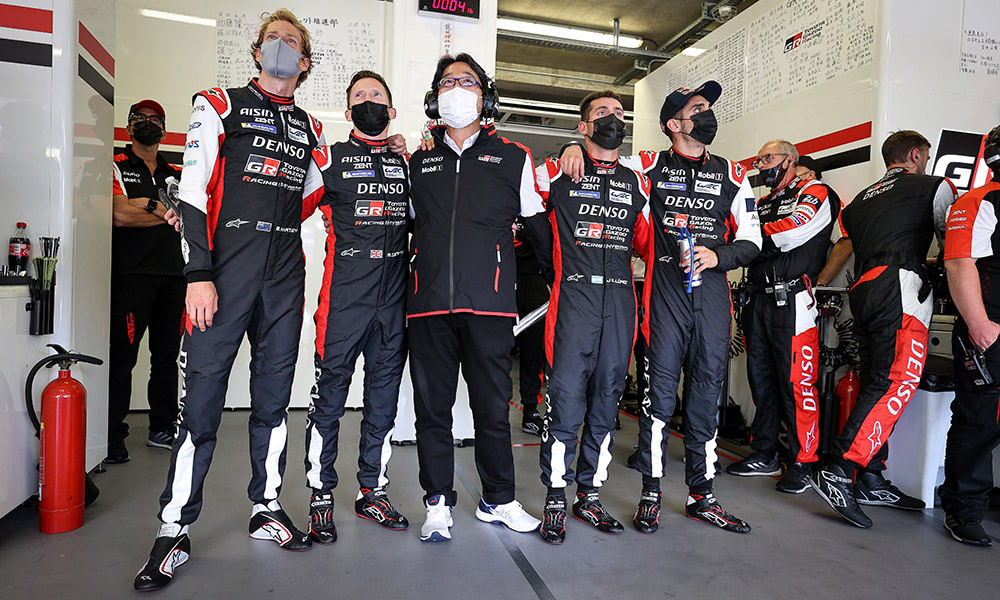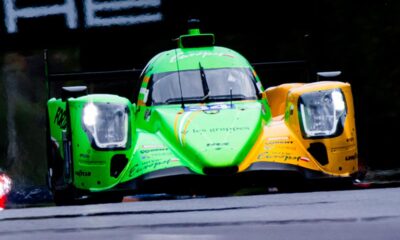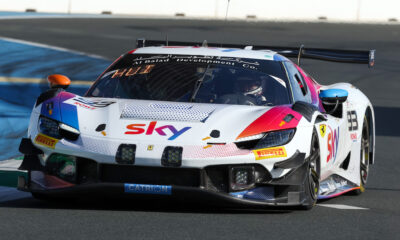
Photo: James Moy/Toyota
Brendon Hartley and Sebastien Buemi believe that finding a workaround to the Toyota GR010 Hybrid’s fuel pressure issue during the 24 Hours of Le Mans made for a “huge team effort.”
The Japanese manufacturer claimed its fourth consecutive Le Mans triumph in an event that saw its 24-hour race debuting Le Mans Hypercar nearly lose out after both cars were struck with fuel contamination-related issues.
The issue first developed on the No. 8 Toyota with about seven hours to go in the race.
“It was happening where our stint length was getting less and less,” Hartley told Sportscar365. “We were doing 13 laps, then down to 7, then 9. At one point I think Seb was doing only a three-lap stint.
“At that point I started to think we would have to come in and change the fuel cell, which I think was a 30-minute change.
“The boys and girls back in the garage came up with a plan, which was an optimistic one.
“There was no guarantees it was going to work by turning the fuel pump off during the brake phase to try and create some back pressure to clear out the filter.
“It was quite a complicated process to try and make that happen.”
Recalling the dramatic moments of the race some two months after it unfolded, Buemi credits Toyota Gazoo Racing’s engineering staff for coming up with a makeshift alternative that the Swiss driver served as the “test dummy.”
“I’d like to give more credit to the engineer that came up with the solution,” he said. I just managed to do the stuff that the engineers told me to do.
“Initially they thought I could do it in only one corner but I ended up doing it in all of the braking [zones] more or less.
“I was able to do what I was told to do. Unfortunately the timing of when you had to do those changes was happening already when you have a lot of things to do.
“It did not happen on the straight line when you only focus on driving. It happened when you brake, so when you downshift, when you look in the mirrors, when you overtake some GTs.
“It was a bit of an extra job. I was a bit drained when I came out of the car because you don’t want to lose time, you don’t want to crash and at the same time you want to do these switch changes in the right way.
“I was the first to be able to do it and then I told my teammates how I was doing it and how it seemed like it worked.”
Buemi believes his vast experience in the ABB FIA Formula E World Championship, which often involves managing energy while in the cockpit, may have helped him in the process.
“The more you practice to change things and having to think about something else means that you can drive your car fast and still have some spare capabilities to do other things,” he said.
“Maybe [my Formula E experience] helped a little bit in that aspect.
“I did not feel like I’m overloaded when I’m driving the car, so if you ask me to do something else, and I was able to do it and not lose lap time, which was kind of nice.
“I don’t ever remember having to do these kind of things in my life, especially for so long!
“We were not talking two or three laps. I nearly did all of my last stints in the car but the other two had to do it for the rest of the race.
“I was happy to get out, to be honest!”
When the same issue struck the race-leading sister Toyota, they were instructed to do the same procedure, which saved its race.
“It saved both cars, and in the end, the victory,” Hartley said. “Car 7 adopted the same procedure when they eventually ran into problems as well.
“It was a huge team effort. From Seb being the test dummy, the girls and guys back at the factory and the back of the garage coming up with the idea and the plan of something to try.
“It was all very well executed. To be honest, I think they were expecting we were going to lose three or four seconds per lap and they calculated that if we were going to lose [that time] it was still going to be better than coming into the box for 30 minutes.
“I think in the end, I was probably only losing two or three tenths, honestly. In the beginning, it was a new procedure and the muscle memory was having a hard time clicking buttons whilst hitting the brake pedal.
“The brake phase is normally the hardest part of our job. It’s when we’re really on the limit of adhesion of all four wheels. Missing the braking point by 10 meters can end up in disaster.
“You’ve already got a lot going on so to add another procedure was tough. But it was surprising that after 20-30 minutes that we all managed to adapt and lost very minimal time.
“I think we all went straight in one of the chicanes once or twice because of it!
“It’s a great team story and shows you that at Le Mans you have to be able to adapt.”
Buemi added: “I think it bounded the team together more. Everyone was expecting to have to stop and lose the race.
“In the end, coming up with that solution and doing it. You have the adrenaline. It was a nice feeling, even though we lost the race as Car 8, it was nice to do it.”


























